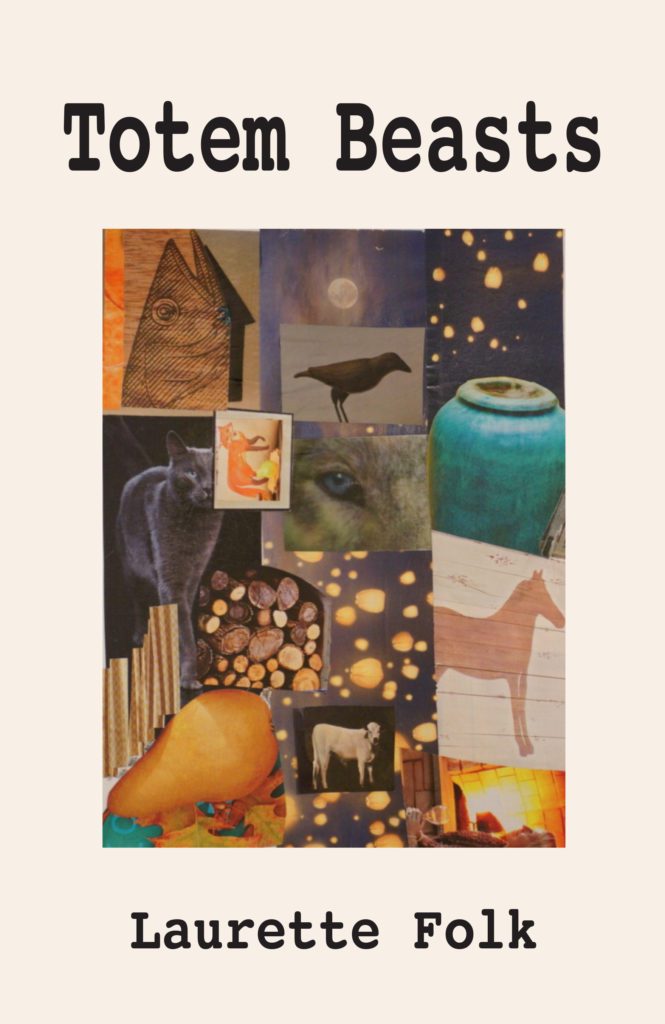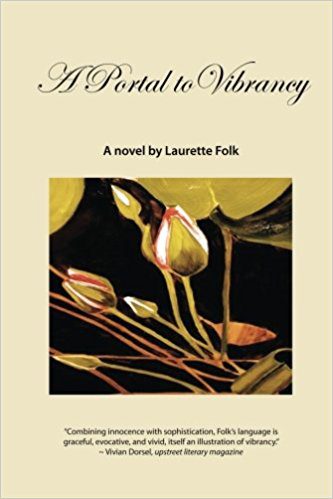Like a rich, hypnotic blend of Jorge Luis Borges and Mary Oliver, Laurette Folk’s mesmerizing new collection, Totem Beasts, exists in a hybrid state between poetry and flash fiction, offering evocative meditations on surviving the ever-complex terrain of family, fertility, grief and self. Her beautiful style and vivid use of archetypes transports readers to surreal dreamscapes where the presence of nature and everyday objects takes on startling new dimensions.
Folk’s writing has appeared in The Boston Globe Magazine, upstreet, Literary Mama, elephant journal, and other publications. She received a semifinalist nomination and “Noted Writer” award from the Boston Fiction Festival and is the author of 2014’s A Portal to Vibrancy. She is the founder and editor of The Compassion Anthology, a literary magazine devoted to fostering greater social awareness and compassion.
In May, I had the pleasure of speaking to Folk about Totem Beasts and her creative process.
***
The Rumpus: In many ways, Totem Beasts is a departure from A Portal to Vibrancy, a coming-of-age novel that follows a young woman as she sheds the restrictive conditioning of her family and religious upbringing. Yet, stylistically, the same rich lyrical narrative and haunting images are at work in many of the poems and hybrid pieces in this new collection. How might your storytelling sensibilities as a fiction writer inform your poetry?
Laurette Folk: From a very young age, I loved language and the images poetry could paint in one’s mind. Being a visual artist as well, it seemed as if I was naturally inclined to this sort of thing. Fiction writing definitely included this, because I have an image-laden style, but storytelling usurped my need for poetry somewhere along the line, even though I found it infinitely more arduous. I think it was the lure of the novel, like it was some great achievement, and my ego took over. I now see writing a poetry collection as a great achievement as well, but it’s somehow more intuitive. I think this collection began from a point of utter humility. For years, I tried to conceive a child, and being older, couldn’t. The poetry started to literally pour out of me when I started IVF treatments. My mind was altered in a way that simply demanded expression.
Rumpus: Perhaps certain experiences demand a specific form to be expressed in order for the psychic wounds or trauma present to be fully realized through language? Certainly, the failure rate and enormous difficulty, emotionally and physically, that so often comes with IVF treatments is no exception. Robert Howard makes the case that Dickinson’s work reveals a “phenomenology of trauma,” that her poetry essentially depicts the “truths about the traumatic state and the distinctive self-experience that it engenders.” Might the form of poetry itself reflect the way the mind processes trauma and grief?
Folk: I am not sure if trauma is the right word. Trauma indicates an event and the processing, or not, that comes with it. I could be wrong, but I don’t think there was any one event that set Dickinson’s mind in motion. I think it was just who she was—someone very susceptible to overstimulation, a creature with a very astute, impressionable, and sensitive disposition.
That’s not to say she wasn’t strong. She had her convictions and that’s what shaped her poetry. And I have to admit that I read Dickinson often, and I feel a kinship with her. I don’t doubt that she was an agoraphobic, as I was at one point. Perhaps fear and sensitivity forced her isolation. But with that forced isolation came a powerful internal landscape that was inspired by the natural world. She felt comfortable there in the natural world, as do I. There are no expectations from the natural world, no commitments, no preconceived ideas, no stress to rattle one’s sensitivities. Also, Emily Dickinson’s internal life was enhanced by this lack of distraction, be it social or otherwise. Her internal world virtually bloomed. But you can’t have that blossoming without pain. They go hand in hand. The grief, the shame, the loneliness, the depression accompanies you as well. It’s just something to accept, and use. So, I’m not sure I see it as a cause and effect situation. I see it as more binary, two states that simultaneously exist to accompany an extreme sensitivity of being.
Rumpus: There is a dreamlike quality to this collection, where individual pieces are rooted in vivid, at times haunting, images edged in surrealism. In “Amanda,” the speaker arrests the reader with “We were traveling along the interstate… when we saw them… children crawling over the infrastructure like rats. We too decided to do this, hang from the beams, shimmy ourselves between gusset plates, swing like monkeys from the girders.” Images unfurl, strange and unexpected, soon revealing how the speaker’s father no longer knows his own name since he began having seizures, signing it instead as Amanda. One’s sense of self becomes disoriented, the narrative brilliantly mirroring the state of her father’s fractured state of mind as his health further deteriorates. How did you approach these pieces, especially perhaps in the context of dreams or the subconscious?
Folk: I wrote down my dreams exactly as they occurred, without over-editing, so that I could capture the true power of the images. I could only do this by practicing meditation on a regular basis and being totally nonjudgmental. I couldn’t let my conscious mind get in the way. “Amanda” was one of the first dreams I “captured,” and I felt like I had an exotic bird in my net. Here was a dream that made absolutely no sense to me when I was awake, and yet when I was having it, made absolute sense. One of the themes in this collection is my search for my father, who died of cancer in 2003. Logically, there is no searching to do, but in the landscape of the subconscious, there is a plethora of answers as to where and who he is now. I tried to capture these. In this dream, the infrastructure is metaphorical for the subconscious, the structure that supports the façade of conscious life.
My father writes to a celebrity in “Amanda.” Celebrities could be interpreted as “the higher realm,” something we lay people see as unattainable except in special circumstances. One can view death that way as well. He was seeking the higher realm. It’s all metaphorical. That’s the way the subconscious works. It uses the language of image and archetype.
Rumpus: Archetypal images also emerge in the vivid portrayal of wild animals and wooded landscapes throughout Totem Beasts, often inviting both speaker and reader alike to merge into a spiritual place of mystery and uncertainty. In “A Roundabout to Wilderness,” the narrative depicts “the land, scared, treacherous, called out to me, and I, stepping from stone to stone, heeded its call.” There is a sense of promise, too, as animals emerge with almost a mythic presence, offering guidance as to how to live and exist in a difficult world, especially as a woman. In “My Anima, My Doe,” the speaker reveals how, “Domesticity claimed me / Because I could not claim myself.” A lack of self or connection to the self is a concern that arises frequently, with speakers hoping to glean some better understanding as to how to live a life beyond what is expected. Could you speak to the presence of totem beasts as a conscious or unconscious dimension to the work, and how this might speak to a woman’s evolving (or limited growth) of a self, her sense of power in the world?
Folk: I started practicing shamanic meditation last year and much of that informed my work. The way I interpret shamanic meditation is a deep meditation using a drum or bowl to access the “underworld” of the subconscious. Here, guides come forth, and they are usually from the natural world. These guides accompany you during a “journey” and you are supposed to reap a message from it. I wasn’t sure if I actually was “journeying” because my trip was more sporadic and less fluid than others’ seem to be. I’m not sure if I had legitimate guides. What I was most interested in were the images to use in my work. So these subconscious images became conscious.
“My Anima, My Doe” is the result of taking long meditative walks in the woods behind my house and getting to know a doe that lived there for a few months. I became very attached to her and then she wasn’t there any more, sort of like my father. But more so, I felt like she trusted me. There was that heightened pleasure that comes from a wild animal connecting with you. She wasn’t with a herd, and oftentimes, neither am I. I’d been carrying that poem inside me for years and finally decided to write it, last fall. When it came out, it had all to do with postpartum depression. [The doe] somehow represented resilience and freedom to me. I had come through the terrifying feelings of hopelessness, and her image reminded me of this.
Rumpus: Poems like “The Madonna at the Table” and “I Dive In” echo the ongoing influence that family has over an individual. Such poems reveal relatives so often bound together by illness, misfortune and abuse. I am reminded more specifically of Totem Beasts’s title poem where “I sit quietly inside myself. / My father bows his head here, / the lines echoing around his eyes.” There is a sense of inheritance in this image, an absorption of familial trauma that circles around loss, the family’s esteemed patriarch. How does such an image speak to themes or issues concerning family for you?
Folk: “Totem Beasts” is really about seeking some heightened experience in the conscious world, but finding it instead in meditation. I was on vacation in Maine one summer, and the house we rented was very old. You could literally feel the history of its bones. I was on the lookout for ghosts, but also ospreys and moose, anything that would give me a rush of wildness. But none had come.
My sister was pregnant at the time. She and her husband were with us, and it was a new beginning for the family after the death of my father. But I had such a vivid image of him inside myself, as if he were waiting. I found it comforting. As far as images go, I was raised in an Italian Catholic family, mass on Sundays, a five-course meal after mass, everyone concerned if you had a boyfriend, etc. That kind of life is chock full of images, symbols, and returning to them was validation of who I am, where I’m from, but also, where I’m headed and how, by defining them, I’ve transcended them.
Rumpus: Has achieving such transcendence allowed you to further develop as a writer or access new terrain in the work?
Folk: Absolutely. It brings a sort of wholeness to one’s being. It’s a kind of power.
Rumpus: Images of new life, conception and pregnancy also appear throughout Totem Beasts, particularly in “In the Garden of Limbo” and “Diaphanous Moments,” which meditate on a woman’s body and personal transformation through the onslaught of infertility, IVF treatments, and pregnancy. In “Zygotes, Hatched and Delivered” and “Three Blind Moles Attach,” the reader is once more immersed with provocative and unexpected images such as “I lay this body down, / toss out statistics/ and pitch the head of Science / on a stick—a notable totem / for an autumn night.” How did you use language as a means of connecting readers to a more intimate understanding of gestation and feminine transformation? What compelled you to write these pieces?
Folk: I was aware that I was at a very crucial point in my life and this is what made everything intense. I needed something to do with that intensity, so writing poetry was the natural response. I also kept Sylvia Plath’s Ariel by my writing table. The images in that book, Path’s unprecedented use of metaphor to “tell it slant” in depicting the psyche and physicality of a woman, and a thinking, suffering woman at that, were a profound model for me. I am still in awe over her work. Plath was at a crucial point in her life, as well. There is something about that edge that impels productivity.
Rumpus: There is something inherent in writing from the edge—that place of intensity—that demands greater complexity and risk. What new books or literary projects do you have in the works right now?
Folk: I am extending the last section of Totem Beasts, called “Upon Waking,” into a book of poetry and flash fiction pieces, so basically I’m continuing along the Totem Beasts path, examining my dreams, using meditation, etc. This type of plunge and release kind through writing seems to fit my life right now, being a mother. It’s a kind of straddling of worlds that I find satisfying.






